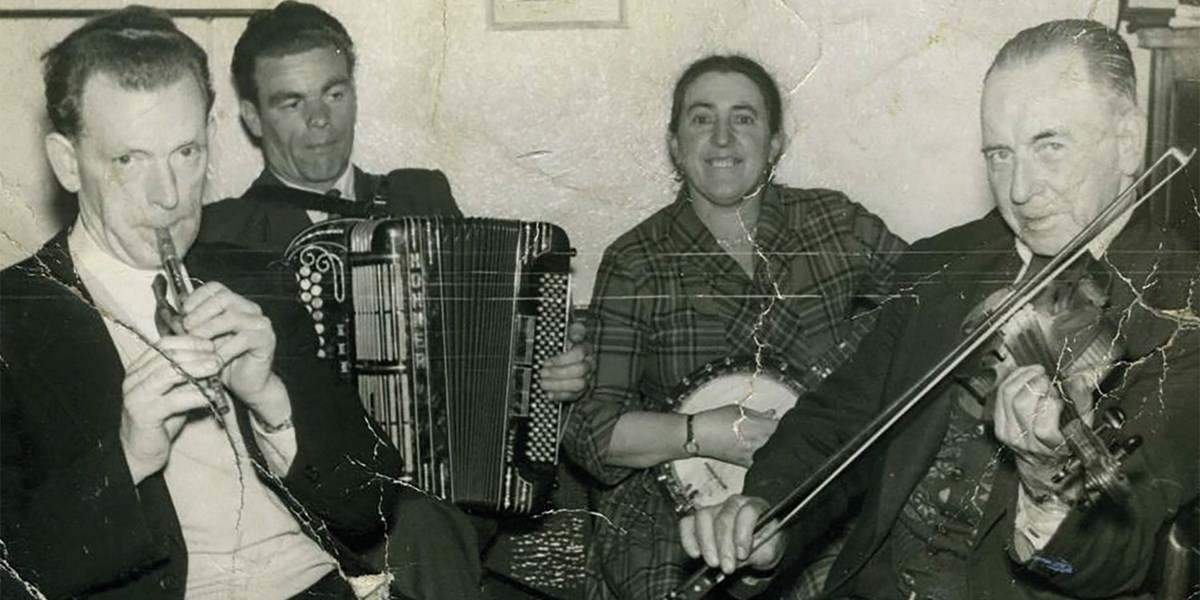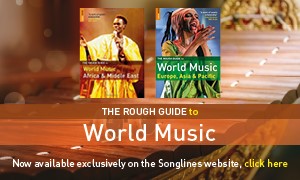Thursday, January 30, 2025
Margaret Barry and The Bedford Arms: “Standing with her banjo slung around her, head thrown back and emitting a sound so loud and clear”
By Alan Woods
Alan Woods takes a look at the legendary Irish singer’s music and the London pub in which she gained much of her reputation

L-R: unidentified, Eddie Pearce, Margaret Barry and Michael Gorman in The Bedford Arms, circa 1957-58
Margaret Barry, the legendary Cork-born musician, is perhaps best known for her time as a street singer. In the 1930s and 40s, she travelled Ireland, singing at fairs, markets and sporting events. But in the 50s, Margaret pursued a new means of living, swapping Ireland’s roads and fairs for North London’s pubs. One in particular became central: The Bedford Arms on Arlington Road, Camden Town.
The 1950s saw many of Ireland’s finest traditional musicians emigrate to England in search of work, leading to a boom of Irish music in London, with traditional sessions becoming a staple of many pubs, particularly those in the north of the city. Margaret Barry first travelled to London in 1953, at the invitation of Alan Lomax to appear on the BBC television series Song Hunter, which a young David Attenborough produced. Margaret made the move permanent in 1954, and after an initial period of busking outside pubs in London’s East End, she got to know publican Pat Murray, who gave her a regular booking after he took over The Bedford Arms.
Described by musician and music historian Reg Hall as a “down at heel” pub showing hints of its “grander Victorian past”, The Bedford was to become one of the, if not the, pre-eminent hub of Irish traditional music in London in the latter half of the 1950s.
According to Reg Hall, Margaret’s first regular booking in The Bedford was with her uncle, Jimmy Cleary, a banjo player who resided in London for a time. Later, around 1955-56, Margaret got to know the Sligo fiddler, Michael Gorman, and they would go on to form a musical partnership which would become iconic in the history of Irish music in London and the bedrock of The Bedford Arms’ musical heyday.
At their peak of playing in The Bedford, Margaret and Michael were booked up to five nights a week, plus a midday session on Sundays. They were usually joined by a third musician to make up ‘the band’, with accordion players such as Tommy Maguire, Eddie Pearce and Kieran Collins being among the line-up over the years. Reg Hall, Michael Plunkett and Paul Gross often played with Margaret and Michael on Monday nights, which were quieter and considered a kind of “practice night”.
A typical night in The Bedford saw the music begin at 9pm, the main bar quickly filling with expatriate Irish labouring men. The band, stationed on a small stage in a corner opposite the bar, played dance tunes, mostly jigs and reels, “with a fervour and power you need to travel a long way to find”, as noted by John Brunner. On occasion, Margaret would stand from her seat, fix her gaze above the crowd and launch into songs which would rise above the din of the patron’s chatter. “Standing with her banjo slung round her, head thrown back and emitting a sound so loud and clear you are startled afresh each time you hear her”, was how Bill Leader encapsulated the scene.
Margaret’s repertoire of songs, honed on the streets of Ireland, was interactive by design. Speaking with Studs Terkel in 1966, she recalled ‘The Blarney Stone’ was among the favourite songs in The Bedford, giving “a great lift up” as the crowd responded to the placenames mentioned in the song. There was a buzz around the pub with Margaret and Michael as the resident musicians. Banjo player Liam Farrell, who would himself go on to have a residency in The Bedford, recalled that when he first moved to London in 1958, he “couldn’t wait” to hear them.
It was also the era of the burgeoning ‘British folk revival’, and as Margaret’s reputation grew, aided by occasional bookings at folk clubs and concerts organised by revivalists such as Ewan MacColl, a new audience of young folkies began to seek her out. In 1958, American musician and folklorist Ralph Rinzler, assisted by Barry Murphy, recorded Margaret and Michael in The Bedford, among a cast of resident musicians. These recordings were later released on the Smithsonian’s Irish Music in London Pubs.
Margaret’s growing renown also attracted the attention of music executive Phil Raymond, who, in early 1959, approached Margaret and Michael in The Bedford Arms, contracting them to tour Ireland, playing to dance hall crowds, and later headline a concert in the Royal Albert Hall. With a new career as stage performers set out, the era of Margaret and Michael as the resident attraction in The Bedford Arms had come to an end.
By 1961, under new management, a jukebox had been installed in The Bedford and the musicians who had kept things going in Margaret and Michael’s absence were forced to move on. In that same 1966 interview with Studs Terkel, Margaret spoke of the change: “The music has left it, and it’s no longer The Bedford Arms to me… but I have it, the memory of The Bedford Arms with me and that’s much more better to me.”
The Bedford Arms closed its doors to the public in 1968 and was demolished soon after. The pub had provided a vital living for Margaret for at least half a decade, and it was the launching ground to the next stage of her life, gaining fame as a performing artist in Ireland. Most of all, it proved to be the venue where Margaret felt most at home in London, accepted and admired by the community of expatriate Irish, of whom she was one herself.

